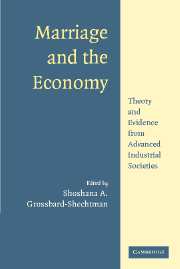Book contents
- Frontmatter
- Contents
- List of Figures
- List of Tables
- List of Contributors
- Foreword
- Acknowledgments
- Marriage and the Economy
- 1 Marriage and the Economy
- PART I THE ECONOMICS OF MARRIAGE AND DIVORCE
- PART II EFFECTS OF MARRIAGE ON INCOME USES
- 5 Control over Money in Marriage
- 6 Marriage, Assets, and Savings
- 7 The Economics of Child Support
- 8 Marriage Prospects and Welfare Use
- PART III EFFECTS OF MARRIAGE ON TIME USES
- PART IV MARRIAGE AND THE MACROECONOMY
- Index
6 - Marriage, Assets, and Savings
Published online by Cambridge University Press: 07 December 2009
- Frontmatter
- Contents
- List of Figures
- List of Tables
- List of Contributors
- Foreword
- Acknowledgments
- Marriage and the Economy
- 1 Marriage and the Economy
- PART I THE ECONOMICS OF MARRIAGE AND DIVORCE
- PART II EFFECTS OF MARRIAGE ON INCOME USES
- 5 Control over Money in Marriage
- 6 Marriage, Assets, and Savings
- 7 The Economics of Child Support
- 8 Marriage Prospects and Welfare Use
- PART III EFFECTS OF MARRIAGE ON TIME USES
- PART IV MARRIAGE AND THE MACROECONOMY
- Index
Summary
There has been considerable research documenting the economic consequences of differences among and transitions between alternative household arrangements (James P. Smith 1988). Invariably, these studies have used some definition of income as the index of economic well-being. While income is certainly critical, wealth is an important complementary measure of a household's command over economic resources. Studies using wealth also have the advantageof informing us about the impact that alternative family arrangements have on individual and aggregate savings, a subject about which we currently know relatively little.
One reason why existing research used income is that until recently, household surveys have measured wealth either quite poorly or not at all (Martin Browning and Annamaria Lusardi 1996). These data limitations were so severe that they discouraged theoretical reasoning about the impact of marriage on savings behavior. Fortunately, this situation has been changing rapidly as a number of social science household surveys now include well-designed wealth modules.
This paper explores the relationship between household type and asset accumulation. Households are distinguished along standard demographic lines – whether they marry, divorce, separate, or become widowed. We rely on two household surveys with high-quality wealth modules. The first – the Health and Retirement Survey (HRS) – is ideal for depicting wealth disparities across households in a relatively narrow age range. Wealth is a core HRS module, and considerable survey resources were spent on improving the quality of the asset information collected. The second survey is the Panel Study of Income Dynamics (PSID), which spans the full age span of households and included wealth modules in its 1984, 1989, and 1994 waves.
- Type
- Chapter
- Information
- Marriage and the EconomyTheory and Evidence from Advanced Industrial Societies, pp. 129 - 152Publisher: Cambridge University PressPrint publication year: 2003
- 64
- Cited by



